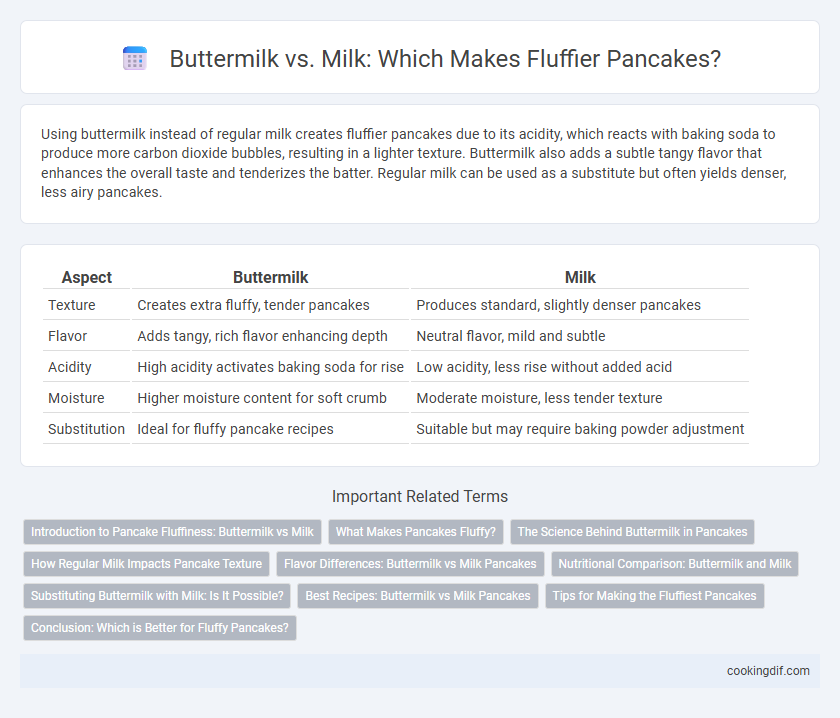Using buttermilk instead of regular milk creates fluffier pancakes due to its acidity, which reacts with baking soda to produce more carbon dioxide bubbles, resulting in a lighter texture. Buttermilk also adds a subtle tangy flavor that enhances the overall taste and tenderizes the batter. Regular milk can be used as a substitute but often yields denser, less airy pancakes.
Table of Comparison
| Aspect | Buttermilk | Milk |
|---|---|---|
| Texture | Creates extra fluffy, tender pancakes | Produces standard, slightly denser pancakes |
| Flavor | Adds tangy, rich flavor enhancing depth | Neutral flavor, mild and subtle |
| Acidity | High acidity activates baking soda for rise | Low acidity, less rise without added acid |
| Moisture | Higher moisture content for soft crumb | Moderate moisture, less tender texture |
| Substitution | Ideal for fluffy pancake recipes | Suitable but may require baking powder adjustment |
Introduction to Pancake Fluffiness: Buttermilk vs Milk
Buttermilk contains lactic acid that reacts with baking soda to produce carbon dioxide bubbles, resulting in lighter, fluffier pancakes compared to milk. The acidity in buttermilk tenderizes gluten strands, enhancing pancake softness and rise. In contrast, milk lacks this acidity, often yielding denser pancakes with a less airy texture.
What Makes Pancakes Fluffy?
Buttermilk's acidity reacts with baking soda to produce carbon dioxide bubbles, creating a light and airy texture that makes pancakes fluffy. In contrast, regular milk lacks this acidic quality, resulting in a denser pancake unless additional leavening agents are adjusted. The key to fluffy pancakes lies in the chemical reaction between buttermilk and leavening agents, which helps the batter rise effectively during cooking.
The Science Behind Buttermilk in Pancakes
Buttermilk contains lactic acid, which reacts with baking soda to produce carbon dioxide bubbles, creating a light and airy pancake texture. The acidity in buttermilk also breaks down gluten, resulting in tender, fluffy pancakes. Milk lacks this acidity, leading to denser pancakes without the same lift and softness.
How Regular Milk Impacts Pancake Texture
Regular milk contributes to pancake batter by providing moisture and mild sweetness, but it lacks the acidity needed to activate baking soda fully, resulting in less rise and a denser texture. The lower acid content in regular milk means the batter doesn't develop the same light, airy crumb that buttermilk promotes through its tangy acidity. Consequently, pancakes made with regular milk tend to be thicker and chewier rather than fluffy and tender.
Flavor Differences: Buttermilk vs Milk Pancakes
Buttermilk pancakes have a tangy, richer flavor due to the lactic acid in buttermilk, which also tenderizes the batter and enhances overall taste complexity. Milk pancakes offer a milder, sweeter flavor that allows toppings and syrups to shine more prominently without overpowering the palate. The choice between buttermilk and milk directly impacts the depth of flavor and texture, making buttermilk ideal for those seeking a traditional, fluffy pancake with a subtle tang.
Nutritional Comparison: Buttermilk and Milk
Buttermilk contains fewer calories and less fat than whole milk, making it a lighter option for fluffy pancakes while providing probiotics that support digestive health. Milk offers higher levels of calcium and vitamin D, essential for bone strength and growth, though it lacks the tangy flavor and acidity that react with baking soda to create fluffier pancakes. Both buttermilk and milk contribute protein and essential nutrients, but the choice impacts pancake texture and nutritional profile significantly.
Substituting Buttermilk with Milk: Is It Possible?
Substituting buttermilk with milk in pancake recipes is possible by adding an acidic ingredient like lemon juice or vinegar to mimic buttermilk's tang and acidity, which activates baking soda for fluffy texture. For each cup of milk, mix in one tablespoon of lemon juice or white vinegar and let it sit for 5-10 minutes before using. This simple substitution maintains the acidity needed for light, airy pancakes without significantly altering flavor or consistency.
Best Recipes: Buttermilk vs Milk Pancakes
Buttermilk pancakes create a tender, fluffy texture due to their acidic content reacting with baking soda, resulting in enhanced rise and softness. Milk pancakes, while lighter in flavor, rely on baking powder and offer a more neutral taste, suitable for versatile recipes. For optimal fluffiness and rich taste, buttermilk-based recipes are preferred in classic pancake preparations.
Tips for Making the Fluffiest Pancakes
Using buttermilk instead of regular milk enhances pancake fluffiness due to its acidity, which activates baking soda, resulting in a lighter texture. For the fluffiest pancakes, combine buttermilk with fresh baking powder and avoid overmixing the batter to maintain airiness. Letting the batter rest for 5-10 minutes before cooking allows gluten to relax and bubbles to form, creating a soft, tender crumb.
Conclusion: Which is Better for Fluffy Pancakes?
Buttermilk's higher acidity and thickness create a tender crumb and enhanced rise, making pancakes fluffier compared to regular milk. Milk provides moisture and a mild flavor but lacks the chemical reaction needed for maximum fluffiness. For the fluffiest pancakes, buttermilk is the preferred choice due to its ability to activate baking soda effectively.
Buttermilk vs Milk for Fluffy Pancakes Infographic

 cookingdif.com
cookingdif.com